Removable dentures on locks
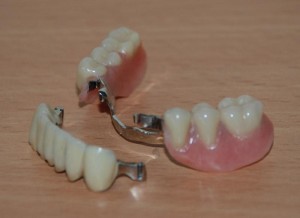
Removable dentures are divided into full and partial dental structures.
A full removable denture is fixed in the oral cavity by suction to the gums. Partial removable structures have a more secure fit than full ones.
Partially removable prostheses can be fixed using clasps (hooks), locks (attachments), on implants, as well as using telescopic crowns.
The disadvantages of removable prosthetics can be avoided by the use of structures with lock fastening.
Before installing the prosthesis with a lock, prepare the abutment teeth, previously covering them with crowns.
Together with artificial crowns, one of the parts of the castle mount is made, the other part of the castle will be on the structure. When donning the structure, both parts of the lock are firmly connected.
At the same time, the prosthesis can be easily removed for hygienic care.
Types of locks
To date, removable dentures on locks have gained great popularity..
The following types of locks are distinguished, the use of which depends on the location of the defects in the dentition:
- Articulated.
- Tough.
- Rotational.
Castle structure
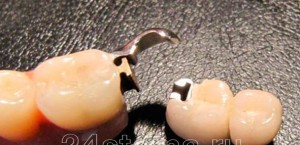
The removable denture lock has the following structure:
- The matrix, which is attached to the artificial crown of the supporting tooth.
- Patricia connected to the dental structure.
Due to the fact that on the front surface of the teeth there are no metal hooks that are visible to others, the design with a lock is more aesthetic than with a clam lock.
The benefits of locking
- Stable structure fixation prevents loosening of supporting teeth.
- A removable prosthesis looks aesthetically pleasing in the oral cavity.
Removable dentures with a locking type of fixation are invisible to others with a quality job. But they are much more expensive than prosthetics with clasp fixation and require coating of supporting teeth with cermet.
Locks can be made at the factory or made individually for a specific case.
Video: “Clasp prosthesis on locks”
Methods for fixing prostheses on locks
There are modern methods of locking fixation of dentures.
Push button lock
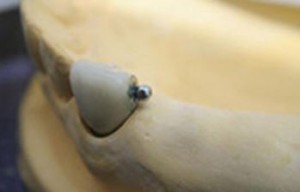
In removable prosthetics, push-button anchors can be used.
Such a button lock is made in the form of a dental insert or is attached to the side surface of the crown of the supporting tooth.
Crossbar lock
The crossbar lock is a way of fixing the prosthesis like a deadbolt.
The design was put on, the bolt was pushed inside, and the prosthesis was firmly fixed.
Beam lock
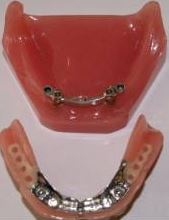
It is a bar between implants or teeth.
- On a removable structure, a groove with a lock is made.
- To create a removable structure on the beam, the saved teeth are covered with crowns (most often gold).
- Between them they let a metal beam with protrusions of a larger diameter than the beam itself.
- The removable part of the structure has a matrix that exactly repeats the non-removable part and easily sits on it.
Removable dentures on telescopic crowns
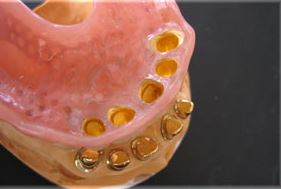
- Their fixation is carried out due to double crowns. One of them is cemented in the oral cavity, the other is part of the prosthesis and fixed in it.
- The crown in the construction is hollow and exactly repeats the shape fixed in the oral cavity.
- When putting on the prosthesis, one of the crowns “enters” the other, according to the type of folding of the telescope, thereby achieving reliable fixation of the structure.
- Of course, there are several such crowns, and they are distributed over the entire surface of the structure in a special way.